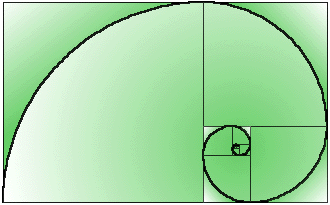Bernoulli's Spiral

We meet this proportion in geometry when we divide a given line segment into two parts, a and b, such that a:b=b:(a+b), where a < b . The ratio b/a is named "tau" and is equal to the positive root of the equation ![]() , which is 1.618033989... It was called "Divine Propotion" (Luca Pacioli, fifteenth-century Italian mathematician and a friend of Leonardo da Vinci) and "one of the two Jewels of Geometry" (Kepler, the celebrated astronomer of the 17th century).
, which is 1.618033989... It was called "Divine Propotion" (Luca Pacioli, fifteenth-century Italian mathematician and a friend of Leonardo da Vinci) and "one of the two Jewels of Geometry" (Kepler, the celebrated astronomer of the 17th century).
The Golden Mean appears at many unexpected turns, in the leaf arrangement on stems, or florets in flowers, Fibonacci series or Pentagon shapes, measurements of the human body or in spiral shapes of mollusks.
This fact we can use to build Bernoulliís Spiral in a rather simple way.
Rectangles whose sides are in the ratio of "tau" to 1 are said to be of the shape most pleasing to the eye; they are called "golden rectangles".
You may take it for granted or you may check it, that the golden rectangle can be dissected into two pieces: a square and a smaller golden rectangle. From the smaller rectangle we can cut off another square, leaving a still smaller rectangle and continue the process indefinitely. Quadrants of circles, inscribed in the successive squares, form a spiral, which is not just a Bernoulliís spiral, but our eye can scarcely distinguish it from the real one.
Bernoulliís spiral occurs naturally in many places like sea-shells where the growth of an organism is proportional to the size of the organism.
This "spira mirabilis" impressed so greatly the imagination of the famous mathematician, that he wished it to be carved on his tomb.
 Back to the Story One page
Spiral's model in Logo
Back to the Story One page
Spiral's model in Logo 